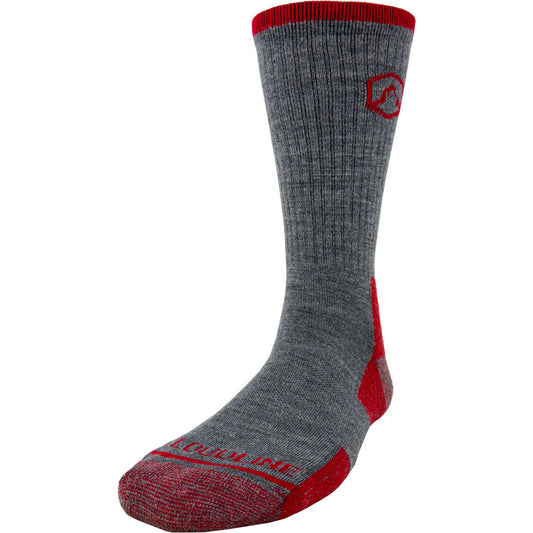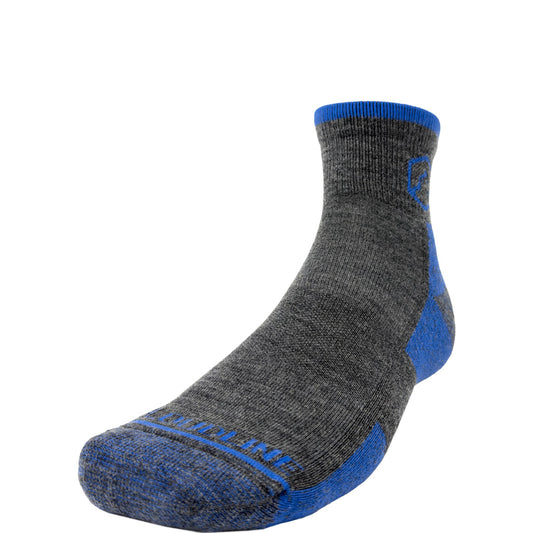
Wool Socks: The Cozy Secret to Happy Feet All Year Round
Why Wool Socks Are a Year-Round Essential
When the temperature drops and winter's chill sets in, most of us instinctively reach for our warmest footwear. But what if I told you that the humble wool sock deserves a permanent spot in your drawer regardless of the season? That's right – wool socks aren't just for frigid winter days. These versatile garments offer a remarkable array of benefits that make them ideal companions for your feet throughout the entire year.
Unlike their synthetic counterparts, wool socks possess natural properties that regulate temperature, wick away moisture, and provide unparalleled comfort. They're not just a cold-weather indulgence but a practical investment in your foot health and overall comfort. From scorching summer hikes to brisk autumn walks, wool socks adapt to your body's needs with an almost uncanny efficiency.
Let's embark on a journey to understand why wool socks have earned their reputation as the unsung heroes of the sock drawer and why discerning individuals are increasingly choosing them over conventional alternatives.
The Science Behind Wool's Year-Round Comfort
The secret to wool's year-round performance lies in its microscopic structure. Each wool fiber contains thousands of tiny air pockets that provide exceptional insulation while simultaneously allowing your feet to breathe. This unique architecture creates what scientists call a "microclimate" around your feet – warm in winter and cool in summer.
Moreover, wool fibers have a natural crimp that creates elasticity, allowing the socks to hug your feet without constricting blood flow. This inherent resilience means wool socks maintain their shape even after repeated wear, unlike cotton socks that often become misshapen and lose their supportive qualities after just a few washes.
"Wool isn't just a fiber; it's an engineering marvel created by nature. The microscopic structure of each strand contains the solution to multiple footwear challenges that synthetic materials attempt to solve with chemicals and artificial processes." - Dr. Emma Richardson, Textile Scientist
The Remarkable Properties of Wool Socks
Wool socks stand apart from their cotton, polyester, and nylon counterparts due to several distinctive properties. Understanding these unique characteristics helps explain why wool socks have remained a steadfast favorite for centuries, despite the introduction of numerous synthetic alternatives.
The exceptional qualities of wool aren't just marketing claims; they're scientifically verified attributes that directly translate to tangible benefits for wearers. From temperature regulation to odor resistance, wool outperforms most synthetic materials across multiple parameters without requiring chemical treatments or specialized manufacturing processes.
Moisture-Wicking and Temperature Regulation
Perhaps wool's most laudable quality is its ability to manage moisture. Wool fibers can absorb up to 30% of their weight in water without feeling wet to the touch. This hygroscopic property allows wool socks to pull moisture away from your skin, keeping your feet dry and preventing the clammy sensation often associated with synthetic materials.
Simultaneously, wool's natural temperature regulation works bidirectionally. In cold conditions, the crimped structure of wool fibers traps warm air close to your skin. When temperatures rise, these same fibers wick away perspiration and allow excess heat to escape. This thermoregulation occurs automatically, requiring no special technology or design features.
Even when wool gets wet – whether from external sources like rain or internal moisture like sweat – it retains its insulating properties. This remarkable characteristic explains why outdoor enthusiasts favor wool socks for activities where variable conditions might be encountered.
Natural Odor Resistance and Antimicrobial Properties
One of wool's less discussed but equally impressive qualities is its natural resistance to odor. The outer layer of wool fibers contains lanolin, a natural wax that has antimicrobial properties. This naturally occurring substance inhibits the growth of bacteria – the primary cause of foot odor.
Additionally, wool's moisture management capabilities create an environment that's less hospitable to odor-causing microbes. By keeping feet drier, wool socks reduce the warm, moist conditions that bacteria thrive in. This means you can wear wool socks for extended periods without developing the unpleasant odors typically associated with synthetic materials.
For travelers, hikers, and anyone who needs reliable footwear for multiple days, this natural odor resistance represents a significant advantage. Many adventurers report wearing the same pair of wool socks for several days without noticeable odor – a claim that would be unthinkable with cotton or synthetic alternatives.
Types of Wool Used in Premium Socks
Not all wool is created equal, and the variety used in sock production significantly impacts the final product's performance, feel, and durability. Understanding the different types of wool can help you make informed decisions when investing in quality wool socks for specific uses or preferences.
The wool industry has evolved dramatically in recent decades, with specialized breeding programs and processing techniques yielding fibers that are finer, softer, and more purpose-specific than ever before. Contemporary wool socks bear little resemblance to the scratchy, bulky options that may have dominated your grandparents' drawer.
Merino: The Gold Standard for Comfort
Merino wool has revolutionized the perception of wool products, offering extraordinary softness without sacrificing performance. Derived from Merino sheep, these fibers measure just 15-24 microns in diameter (compared to 25-40 microns for regular wool), making them incredibly fine and non-irritating even for sensitive skin.
The superfine structure of Merino wool makes it the preferred choice for next-to-skin applications. Unlike conventional wool that might feel itchy or abrasive, Merino wool feels luxuriously soft while still delivering the temperature regulation, moisture-wicking, and odor resistance wool is celebrated for.
Premium sock manufacturers often specify the micron count of their Merino wool – with lower numbers indicating finer, softer fibers. Ultralight Merino socks with fibers under 17 microns can rival cotton in softness while dramatically outperforming it in technical attributes.
Specialty Wools: Alpaca, Cashmere, and Blends
Beyond Merino, several specialty wools have carved out niches in the sock market, each offering distinctive characteristics:
- Alpaca wool provides exceptional warmth with minimal weight. Its hollow fiber structure creates superior insulation, making it ideal for extreme cold weather conditions.
- Cashmere offers unparalleled softness but comes with a higher price tag and somewhat reduced durability compared to sheep's wool.
- Mohair, from Angora goats, adds tremendous durability and luster to wool blends, making it popular for hikers seeking longevity.
Most premium wool socks contain carefully calculated blends of different fibers. Manufacturers might combine Merino wool with small percentages of synthetic fibers like nylon to enhance durability at stress points, or add elastane to improve stretch and recovery. These technical blends aim to preserve wool's natural benefits while addressing its few shortcomings.
| Wool Type | Fiber Diameter (microns) | Notable Characteristics |
|---|---|---|
| Standard Wool | 25-40 | Durable, warm, potentially itchy |
| Merino Wool | 15-24 | Soft, fine, excellent temperature regulation |
| Alpaca Wool | 20-30 | Lightweight, exceptional warmth, hypoallergenic |
| Cashmere | 14-16 | Ultra-soft, luxurious feel, less durable |
Seasonal Benefits of Wool Socks
The remarkable versatility of wool socks becomes most apparent when examining their performance across different seasons. Unlike most clothing items that serve specific seasonal purposes, quality wool socks adapt to changing conditions, making them relevant year-round investments rather than seasonal purchases.
This adaptability stems from wool's unique response to both environmental conditions and the microclimate created by your feet. Let's explore how wool socks perform across the calendar and why they might be the most versatile item in your drawer.
Winter Protection: Beyond Basic Warmth
Winter presents the most obvious use case for wool socks, but their cold-weather benefits extend far beyond simple warmth. The natural insulation provided by wool fibers creates an effective barrier against frigid temperatures without the bulk associated with synthetic insulators.
Crucially, wool retains its insulating properties even when wet – a vital characteristic in winter conditions when snow, slush, and perspiration threaten comfort. This hydrophobic quality stems from wool's water-repellent outer layer combined with a hygroscopic interior that can absorb significant moisture without compromising thermal efficiency.
For winter sports enthusiasts and cold-weather adventurers, wool's ability to maintain warmth even during periods of inactivity after exertion represents a significant safety advantage. Unlike cotton that becomes dangerously cold when wet, wool continues to insulate, reducing hypothermia risk in challenging conditions.
Summer Comfort: Cooling Properties Explained
Counterintuitively, lightweight wool socks excel in summer conditions. The same fibers that trap heat in winter effectively dissipate it during warmer months. This temperature regulation stems from wool's ability to absorb perspiration into the fiber core while remaining dry to the touch on the surface.
Ultrafine Merino wool socks ranging from 13-17 microns provide exceptional hot-weather performance. These lightweight options (typically 150-200g/m² weight) wick moisture away from your feet more effectively than cotton or synthetic alternatives, preventing the slippery, blister-causing conditions that plague many summer hikers and athletes.
In arid conditions, wool's moisture absorption creates a cooling effect as perspiration evaporates gradually rather than immediately. This drawn-out cooling process helps stabilize foot temperature during extended outdoor activities, preventing the temperature spikes and dips common with less adaptive materials.
Caring for Your Wool Socks
Quality wool socks represent a meaningful investment in foot comfort and performance. With proper care, premium wool socks can deliver years of service, making them economical despite their higher initial cost compared to cotton or synthetic alternatives.
Fortunately, modern wool socks are significantly easier to maintain than their historical counterparts. Advances in processing and fiber technology have created wool products that resist shrinking and maintain their shape even with machine washing. Still, following some basic care guidelines will maximize the lifespan of your wool footwear.
Washing and Drying Best Practices
Despite common misconceptions, most contemporary wool socks can be machine washed with minimal special treatment. However, a few adjustments to your usual laundry routine will significantly extend their lifespan:
- Use cold or lukewarm water with mild detergent. Hot water may cause shrinkage and fiber damage.
- Avoid fabric softeners, which coat fibers and reduce wool's natural wicking properties.
- Turn socks inside out before washing to remove skin cells and body oils more effectively.
- Use a gentle cycle or wool-specific setting if available on your washing machine.
- Consider using a mesh laundry bag to prevent excessive agitation during the wash cycle.
Drying represents the most critical phase of wool care. While many modern wool socks can withstand machine drying on low heat, air drying extends fiber life considerably. Lay socks flat rather than hanging them to prevent stretching, and keep them away from direct sunlight, which can fade colors and degrade fibers.
Extending Longevity Through Proper Storage
The care regimen for wool socks extends beyond washing to proper storage practices. Unlike synthetic fibers, wool benefits from rest periods between wears, allowing the natural elasticity of fibers to recover and moisture to fully dissipate.
Store wool socks in a cool, dry environment away from direct sunlight. Avoid compressing them for extended periods, as this can permanently deform the natural crimp of wool fibers. For long-term storage, particularly during off-seasons, ensure socks are completely clean and dry before placing them in breathable containers.
Many wool enthusiasts recommend cedar storage accessories, as the natural oils in cedar repel moths – one of the few threats to stored wool products. Lavender sachets offer a pleasant-smelling alternative that similarly deters potential pests without the chemical concerns of mothballs.
Frequently Asked Questions About Wool Socks
Are wool socks worth the investment?
Quality wool socks typically cost $15-30 per pair – substantially more than basic cotton alternatives. However, when evaluated on a cost-per-wear basis, wool socks often represent superior value. Their exceptional durability means a premium pair might last 3-5 years with proper care, compared to 6-12 months for typical cotton socks.
Beyond longevity, wool socks provide performance benefits that can't be replicated by lower-cost alternatives. For individuals with specific comfort needs, outdoor enthusiasts, or those who spend significant time on their feet, the comfort and performance advantages justify the initial investment many times over.
Can people with wool allergies wear wool socks?
True wool allergies are extremely rare, affecting less than 1% of the population. What many people identify as a "wool allergy" is actually sensitivity to coarser fibers that cause mechanical irritation rather than allergic reactions. For these individuals, superfine Merino wool (under 17 microns) often proves completely comfortable.
Some manufacturers now offer specially processed hypoallergenic wool socks that remove lanolin and other potential sensitizers. These products retain wool's performance benefits while eliminating most reaction triggers. Additionally, wool blends with higher percentages of synthetic fibers can provide partial wool benefits with reduced potential for skin irritation.
What thickness of wool socks is best?
The ideal thickness depends entirely on your intended use and personal preferences. Modern wool socks come in diverse weights:
- Ultralight (around 200g/m²): Perfect for summer conditions, formal shoes, or tight-fitting athletic footwear
- Lightweight (200-300g/m²): Versatile year-round options suitable for most everyday activities
- Midweight (300-400g/m²): Ideal for hiking, winter sports, or moderately cold conditions
Many wool sock enthusiasts maintain a collection spanning multiple thicknesses to address varying conditions and activities. This approach maximizes the versatility of their investment while ensuring appropriate foot protection across diverse scenarios.
Remember that a sock's warmth doesn't correlate directly with thickness – fiber type, density, and knit structure all influence thermal performance. A well-designed lightweight Merino sock might provide better insulation than a thicker sock made from lower-quality wool or poorly engineered synthetic materials.




